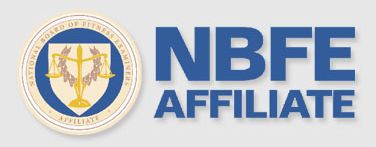Yoga Alliance - The NAFC perspective
A Yoga Alliance certificate does not denote the credential, accreditation, or credibility one may be lead to believe.
Being registered with Yoga Alliance does not constitute a genuine education credential.
Yoga Alliance does not conduct certification exams or independent assessments of any Registered Yoga Teachers (RYT®s).
Rather, the RYT® credential is derivative of the Registered Yoga School (RYS®) or school registry, and is entirely voluntary.
This is where an organization such as NAFC, with true educational accreditation and licensure, comes into play.
NAFC's mission is to provide substantive, proven fitness and health education to professionals in the industry, ensuring their credibility and value to clients,
members, and even medical professionals. The Yoga 200™ certification course is a part of this mission.
Read more
There are several published articles in which Yoga schools identify Yoga Alliance as having a negative impact on Yoga. This is due to very minimal guidelines and educational
credibility, there are far too many Yoga classes happening these days that are teaching/leading risky movement/poses taught by minimally educated teachers.
Yoga practice has been documented to offer many profound benefits, but it’s also producing an enormous amount of injury.
As excerpted in the New York Times, Pulitzer Prize-winning writer William Broad stated,
“a growing body of medical evidence supports (the) contention that, for many people, a number of commonly taught Yoga poses are inherently risky.
The problems can and have ranged relatively mild injuries to permanent disabilities”.
Surveys by the Consumer Product Safety Commission showed that the number of emergency room admissions related to yoga,
after years of slow increases, was rising quickly due to no regulations.
The populations that are being taught, for the most part, sit in chairs all day and rarely lift anything heavier than an iPad.
After sitting all day, they then go to yoga classes, for an hour or more, they flow quickly through poses,
bearing weight in an unfamiliar way on their wrists, spines, and knees. The irony is, yoga was developed to help heal.
The number of Americans doing yoga has risen which means that there is now an abundance of studios where many teachers lack the deeper
training necessary to recognize when students are headed toward injury. Currently, there is no specific curriculum that is
required to be taught, nor is there any required assessment of a registered teacher’s skill.
Simply requiring that a certain number of hours be spent covering each of the five areas of study
(practice, methodology, anatomy, philosophy and ethics, and hours of practice teaching), is not enough.
https://www.yogaalliance.org/Designations/Standards/Educational_Categories
The content is left up to the school that does register through Yoga Alliance. There has been an astonishing decline in the quality of classes over the past 20 years. What is needed is a lengthy set of specific objectives that a Yoga teacher training needs to meet, as is the standard almost all other vocational training. There needs to be a body that ensures that all yoga teachers are appropriately educated, trained, and considered credible. It is NAFC’s intent to train/educate our students/teachers in a manner that honors science, functional movement, critical thinking skills, safe practices, integrity, compassion, growth, all the while keeping the Yoga community in-tact.
NAFC is recognized as a true educational body and being noticed by the medical community. Our mission is to bridge the gap between medical and fitness. With the PHIT act (Yoga Alliance is for the PHIT act) being pushed to legislature, there is a chance the government will more than likely also take into consideration the credentials of the trainers/teachers leading these classes that will be considered a pre-tax deduction with medical expenses. Accreditations and long distance learning is recognized by the US Higher Education and it has established credibility. Accreditation has long been recognized in the domains of hospitals, rehabilitation and higher education as the way to maintain higher standards of accountability and quality. There are concerns with lack of credibility in the fitness industry. NAFC is dedicated to improving the quality, standards, and outcomes of preventative health care services while also educating the public on health fitness and wellness issues. Today’s fitness consumers are more sophisticated and knowledgeable than ever, and, they want more information about their fitness and wellness provider. Insurance companies are seeing more accountability and professionalism for they’re “after care health club memberships”. Medical practitioners are more concerned than ever about the professional qualifications of people they refer their patients to for exercise programs. Performance indicators are becoming more important than ever in medical rehabilitation services. I believe it would be in Yoga Alliances’ interest to also consider long distance learning schools and licensures to stay relevant in a changing industry where medical/fitness integration IS happening.
We realize that Yoga Alliance is against licensure and regulation(s), however, the industry continues to evolve and is headed in the direction of licensure because of the increase of injuries, the correlation with medical, and non-regulated organizations/agencies providing so called ‘standards’ that have actually provided a negative impact for both our populations and fitness professionals.
Yoga and Long Distance Learning
US Department of education data from 2016 (Distance Education is a Key Component of Higher Education in the United States):
http://wcet.wiche.edu/initiatives/research/WCET-Distance-Education-Enrollment-Report-2016
2002: 1.6 million students taking at least one Long Distance Learning Course
2008: 4.6 million students taking at least one Long Distance Learning Course
2014: 5.8 million students taking at least one Long Distance Learning Course
And this continues to rise - One-in-seven (14%) of all higher education students took all of their courses “exclusively” at a distance.
More than one in four students (28%) enrolled in at least one of their courses at a distance in the fall of 2014.
![]() {[{ product.name }]}
{[{ product.name }]}



